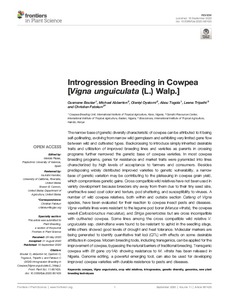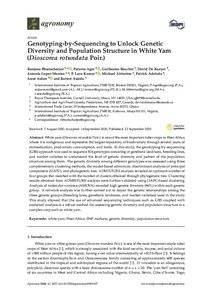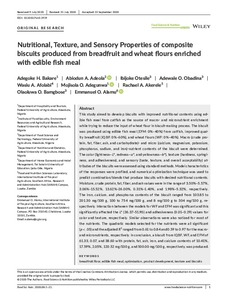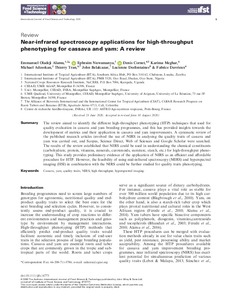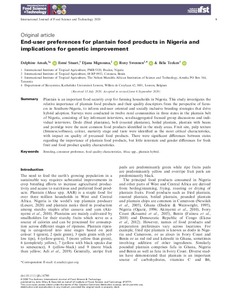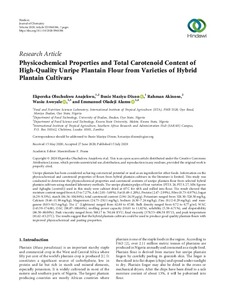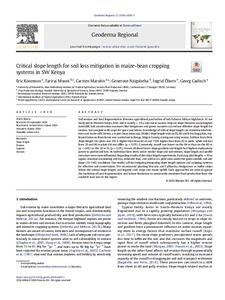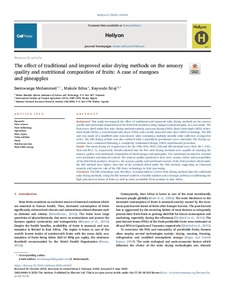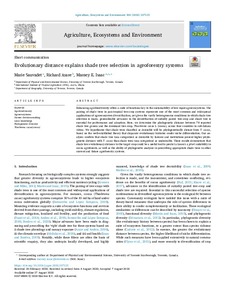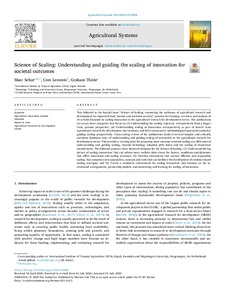Welcome to the International Institute of Tropical Agriculture Research Repository
Journal and Journal Articles: Recent submissions
Now showing items 1081-1100 of 5157
-
Introgression breeding in cowpea [Vigna unguiculata (L.) walp.]
(2020)The narrow base of genetic diversity characteristic of cowpea can be attributed to it being self-pollinating, evolving from narrow wild germplasm and exhibiting very limited gene flow between wild and cultivated types. Backcrossing to introduce simply inherited desirable traits and utilization of improved breeding lines and varieties as parents in crossing programs further narrowed the genetic base of cowpea varieties. In most cowpea breeding programs, genes for resistance and market traits were ... -
Genotyping-by-sequencing to unlock genetic diversity and population structure in white yam (dioscorea rotundata poir.)
(2020)White yam (Dioscorearotundata Poir.) is one of the most important tuber crops in West Africa, where it is indigenous and represents the largest repository of biodiversity through several years of domestication, production, consumption, and trade. In this study, the genotyping-by-sequencing (GBS) approach was used to sequence 814 genotypes consisting of genebank landraces, breeding lines, and market varieties to understand the level of genetic diversity and pattern of the population structure among ... -
Nutritional, texture, and sensory properties of composite biscuits produced from breadfruit and wheat flours enriched with edible fish meal
(2020)This study aimed to develop biscuits with improved nutritional contents using edible fish meal from catfish as the source of macro‐ and micronutrient enrichment while trying to reduce the input of wheat flour in biscuit‐making process. The biscuit was produced using edible fish meal (EFM: 0%–40%) from catfish, improved quality breadfruit (IQBF: 0%–60%), and wheat flours (WF: 0%–40%). Macro (crude protein, fat, fiber, ash, and carbohydrate)‐ and micro (calcium, magnesium, potassium, phosphorus, ... -
Near-infrared spectroscopy applications for high-throughput phenotyping for cassava and yam: a review
(2020)The review aimed to identify the different high‐throughput phenotyping (HTP) techniques that used for quality evaluation in cassava and yam breeding programmes, and this has provided insights towards the development of metrics and their application in cassava and yam improvements. A systematic review of the published research articles involved the use of NIRS in analysing the quality traits of cassava and yam was carried out, and Scopus, Science Direct, Web of Sciences and Google Scholar were ... -
In-situ chlorophyll fluorescence and related growth of white Guinea yam at different ages
(2004)Leaf chlorophyll photochemical attributes and growth of two cultivars of white Guinea yam (Dioscorea rotundata) were examined. The photochemical efficiency (Fv/Fm ratio) of cv. Pepa was significantly higher than that of cv. Abi at 10, 14 and 22 weeks after transplanting (WAT). The peak photosynthetic efficiency period for both cultivars was at 18 WAT. Leaf area indices and crop growth rate were greater for Pepa than Abi, as was the leaf transpiration rate. During peak growth periods Pepa was less ... -
End-user preferences for plantain food products in Nigeria and implications for genetic improvement
(2020)Plantain is an important food security crop for farming households in Nigeria. This study investigates the relative importance of plantain food products and their quality descriptors from the perspective of farmers in Southern‐Nigeria, to inform end‐user oriented and socially inclusive breeding strategies that drive hybrid adoption. Surveys were conducted in twelve rural communities in three states in the plantain belt of Nigeria, consisting of key informant interviews, sex‐disaggregated focused ... -
Economic impacts of fall armyworm and its management strategies: evidence from southern Ethiopia
(2020-09)This paper explores the economic implications of fall armyworm (FAW) and its management strategies by exploiting exogenous variation in FAW exposure amongst households in southern Ethiopia. We find that FAW exposure affects maize yield and sales negatively, but not consumption. Furthermore, we find evidence of crowding-in and intensification of insecticide use in response to FAW exposure. We also find suggestive evidence that existing extension service arrangements lack the capacity to deal with ... -
Appraisal and composition of some traditional complementary foods for infant nutrition in Sierra Leone
(2020)Malnutrition among infants in Sierra Leone still ranks one of the highest globally. Potency of some locally-formulated complementary food at resolving the problem had been proven. The experiment aimed at evaluating nutrient contents in traditional complementary foods consumed by infants in Eastern and Northern regions of Sierra Leone was carried out between 2016 and 2018. Ten common recipes identified through semi-structured questionnaire were standardized and analyzed using standard laboratory ... -
Comparative assessment of genetic diversity matrices and clustering methods in white Guinea yam (Dioscorea rotundata) based on morphological and molecular markers
(2020)Understanding the diversity and genetic relationships among and within crop germplasm is invaluable for genetic improvement. This study assessed genetic diversity in a panel of 173 D. rotundata accessions using joint analysis for 23 morphological traits and 136,429 SNP markers from the whole-genome resequencing platform. Various diversity matrices and clustering methods were evaluated for a comprehensive characterization of genetic diversity in white Guinea yam from West Africa at phenotypic and ... -
Combining ability of extra-early maize inbreds derived from a cross between maize and Zea diploperennis and hybrid performance under contrasting environments
(2020)Knowledge of the genetic mechanisms conditioning drought tolerance in maize is crucial to the success of hybrid breeding programs aimed at developing high-yielding cultivars under drought. The objectives of this study were to determine the combining ability of extra-early inbreds, compute the heritability of measured traits, assess the performance of inbreds in hybrid combinations and investigate the associations among traits under drought and optimal conditions. A total of 252 hybrids generated ... -
Physicochemical properties and total carotenoid content of high-quality unripe plantain flour from varieties of hybrid plantain cultivars
(2020)Unripe plantain has been considered as having commercial potential or used as an ingredient for other foods. Information on the physicochemical and carotenoid properties of flours from hybrid plantain cultivars in the literature is limited. This study was conducted to determine the physicochemical properties and carotenoid contents of unripe plantain flour from selected hybrid plantain cultivars using standard laboratory methods. The unripe plantain pulps of four varieties (PITA 26, PITA 27, Mbi ... -
Critical slope length for soil loss mitigation in maize-bean cropping systems in SW Kenya
(2020)Soil erosion and land fragmentation threaten agricultural production of sub-Saharan African highlands. At our study site in Western Kenya, farm size is mostly < 2 ha, laid out in narrow strips in slope direction and ploughed downhill. Soil conservation measures like hedgerows and green manures can reduce effective slope length for erosion, but compete with crops for space and labour. Knowledge of critical slope length can minimise interventions and trade–offs. Hence, a maize–bean intercrop (MzBn) ... -
Effect-directed profiling and identification of bioactive metabolites from field, in vitro -grown and acclimatized Musa spp. accessions using high-performance thin-layer chromatography-mass spectrometry
(2020-04-12)Bananas and plantains ( Musa spp.) are used as nutritious foods, and at the same time, are a source of phytoconstituents for the pharmaceutical industry. As biological activities of especially the pulp and peel of Musa spp. have been documented, this study investigated the variation in the secondary metabo- lite profiles of the leaves from field, in vitro -grown and acclimatized accessions. The genetic fidelity of the diverse accessions was assessed using diversity array technology sequencing. It ... -
Productivity, water- and nitrogen-use efficiency, and profitability of pearl millet (Pennisetum glaucum) under different nitrogen applications in semiarid region of Nigeria
(2020-08-27)An experiment was conducted to examine the performance of pearl millet under different nitrogen (N) fertilizer rates in two locations in the semiarid zone of Nigeria. The objective was to evaluate the effects of different N rates on pearl millet yields, water- and nitrogen-use efficiency, and profitability. Grain yield increased by 23, 26, 32, 32, and 27% and by 38, 41, 54, 58, and 56% compared to unfertilized plots when applying 20, 40, 60, 80, and 100 kg Nha−1 in Minjibir and Gambawa, respectively. ... -
The effect of traditional and improved solar drying methods on the sensory quality and nutritional composition of fruits: a case of mangoes and pineapples
(2020-06)Background This study investigated the effect of traditional and improved solar drying methods on the sensory quality and nutritional composition of the dried fruit products; using mangoes and pineapples, as a case study. The fruits were dried under five solar drying methods namely; open sun drying (OSD), black-cloth shade (BCS), white-cloth shade (WCS), a conventional solar dryer (CSD), and a newly improved solar dryer (ISD) technology. The ISD unit was made of a modified solar concentrator ... -
Evolutionary distance explains shade tree selection in agroforestry systems
(2020-12)Enhancing agrobiodiversity offers a suite of functions key to the sustainability of low input agroecosystems. The pairing of shade trees in pan-tropical tree-crop systems represents one of the most common and widespread applications of agroecosystem diversification, yet given the vastly heterogeneous conditions in which shade tree selection is made, generalizable advances in the identification of suitably paired tree-crop and shade tree is essential for performance and adoption. Here, we determine ... -
Science of scaling: understanding and guiding the scaling of innovation for societal outcomes
(2020-09)This Editorial to the Special Issue “Science of Scaling: connecting the pathways of agricultural research and development for improved food, income and nutrition security” presents the framing, overview and analysis of 10 articles focussed on scaling innovation in the agricultural research for development sector. The publications cut across three categories that focus on: (i) Understanding the scaling trajectory retrospectively from a longer term, systems perspective, (ii) Understanding scaling ... -
Bioactivity of essential oils of Cymbopogon citratus (DC) Stapf and Cymbopogon nardus (L.) W. Watson from Benin against Dinoderus porcellus Lesne (Coleoptera: Bostrichidae) infesting yam chips
(2020-08-18)Dinoderus porcellus L. (Coleoptera: Bostrichidae) is a most abundant and damageable pest of stored yam chips in West Africa. In view of the negative effects related to the use of synthetic chemical insecticide, it is important to develop alternative eco-friendly methods of control, such as the use of plant essential oils. The chemical composition and biological effects (repellent, antifeedant, contact and fumigant toxicity) of essential oils from Cymbopogon citratus (DC) Stapf and Cymbopogon nardus ... -
Modeling planting-date effects on intermediate-maturing maize in contrasting environments in the Nigerian savanna: an application of DSSAT model
(2020-06)The Crop Environment Resource Synthesis (CERES)-Maize model in Decision Support System for Agricultural Technology Transfer (DSSAT) was calibrated and evaluated with experimental data for simulation of response of two intermediate-maturing maize varieties to different sowing dates in the Nigerian savannas. The calibration experiments involved 14 consecutive field trials conducted in the rainy and dry seasons in Bayero University Kano (BUK), Dambatta, and Zaria between 2014–2019. Two sets of field ... -
Canopy cover evolution, diurnal patterns and leaf area index relationships in a Mchare and Cavendish banana cultivar under different soil moisture regimes
(2020-10)The biggest abiotic threat to banana (Musa spp.) production is water deficit, but physiological indicators in plantations are lacking. Canopy Cover (CC) seems to be a relevant parameter, but so far not used in banana fields. Field experiments were conducted to determine the effect of optimal irrigation (FI) versus rainfed (RF) on CC and Leaf Area Indices (LAI) in two experiments with different cultivars (Mchare ‘Huti Green’ [HG, AA] and Cavendish ‘Grand Naine’[GN, AAA]) (n = 3 for HG, n = 4 for ...

